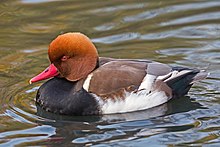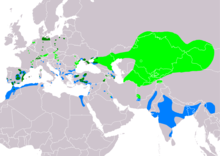A | B | C | D | E | F | G | H | CH | I | J | K | L | M | N | O | P | Q | R | S | T | U | V | W | X | Y | Z | 0 | 1 | 2 | 3 | 4 | 5 | 6 | 7 | 8 | 9
| Red-crested pochard | |
|---|---|

| |
| Male | |

| |
| Female | |
| Scientific classification | |
| Domain: | Eukaryota |
| Kingdom: | Animalia |
| Phylum: | Chordata |
| Clade: | Dinosauria |
| Class: | Aves |
| Order: | Anseriformes |
| Family: | Anatidae |
| Genus: | Netta |
| Species: | N. rufina
|
| Binomial name | |
| Netta rufina (Pallas, 1773)
| |

| |
| Range of N. rufina Breeding Resident Non-breeding
| |

The red-crested pochard (Netta rufina) is a large diving duck. The scientific name is derived from Greek Netta "duck", and Latin rufina, "golden-red" (from rufus, "ruddy").[2] Its breeding habitat is lowland marshes and lakes in southern Europe and it extends from the steppe and semi-desert areas on the Black Sea to Central Asia and Mongolia, wintering in the Indian Subcontinent and Africa. It is somewhat migratory, and northern birds winter further south into north Africa.
The adult male is unmistakable. It has a rounded orange head, red bill and black breast. The flanks are white, the back brown, and the tail black. The female is mainly a pale brown, with a darker back and crown and a whitish face. Eclipse males are like females but with red bills. They are gregarious birds, forming large flocks in winter, often mixed with other diving ducks, such as common pochards. They feed mainly by diving or dabbling. They eat aquatic plants, and typically upend for food more than most diving ducks.
A wheezing veht call can be given by the male. Series of hoarse vrah-vrah-vrah calls can also be heard from females.
Red-crested pochards build nests by the lakeside among vegetation and lay 8–12 pale green eggs. The birds' status in the British Isles is much confused because there have been many escapes and deliberate releases over the years, as well as natural visitors from the continent. However, it is most likely that they are escapees that are now breeding wild and have built up a successful feral population. They are most numerous around areas of England including Gloucestershire, Oxfordshire, Northamptonshire and also spotted in Leicestershire.
The red-crested pochard is one of the species to which the Agreement on the Conservation of African-Eurasian Migratory Waterbirds (AEWA) applies.
References
- ^ BirdLife International (2016). "Netta rufina". IUCN Red List of Threatened Species. 2016: e.T22680348A86012189. doi:10.2305/IUCN.UK.2016-3.RLTS.T22680348A86012189.en. Retrieved 13 November 2021.
- ^ Jobling, James A (2010). The Helm Dictionary of Scientific Bird Names. London: Christopher Helm. pp. 269, 342. ISBN 978-1-4081-2501-4.
External links
- RSPB Birds by Name
- BirdLife species factsheet for Netta rufina
- "Netta rufina". Avibase.
- "Red-crested pochard media". Internet Bird Collection.
- Red-crested pochard photo gallery at VIREO (Drexel University)
- Interactive range map of Netta rufina at IUCN Red List maps
- Audio recordings of Red-crested pochard on Xeno-canto.
>Text je dostupný pod licencí Creative Commons Uveďte autora – Zachovejte licenci, případně za dalších podmínek. Podrobnosti naleznete na stránce Podmínky užití.
Text je dostupný za podmienok Creative
Commons Attribution/Share-Alike License 3.0 Unported; prípadne za ďalších
podmienok.
Podrobnejšie informácie nájdete na stránke Podmienky
použitia.


